By Maxine Carter-Lome, publisher
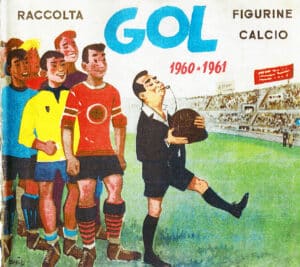
Trading cards and stickers are not new to the collectibles world or ephemera collectors. Nor are the subjects printed on these small pieces of paper, the basic marketing principles behind the business itself, or the thrill of the “hunt” for collectors.
Advertising trade cards, tobacco cards, baseball cards, game cards, stickers, and stamps – those from the 19th century and those being issued today – continue to fuel inter-generational interest among fans and collectors of all ages. Like all collectors, those with an interest in this type of ephemera love to meet up with others, either in person at swap meets and paper shows or online, to buy, sell, and trade, and are always seeking the elusive in order to complete a set.
By the second half of the 20th century, the popularity and proliferation of sports-themed trading cards and stickers were literally changing both the intent of collectors and the business side of sports trading card collectibles. Today, it is brands such as Topps, Fleer, Bowman, Donruss, Upper Deck, and Panini that reign supreme for both early, new, and series re-issued cards and head-turning card values. Among these giants in the trading card marketplace, Panini is probably the least well-known in the U.S.; however, talk to sports fans and collectors the world over and you’ll find buying, trading, and collecting Paninis is always on their mind.
From Humble Beginnings
After WWI and the death of her husband, Olga Panini took over the family’s newspaper kiosk on a street corner in downtown Moderna, Italy with her four sons. In 1960, her oldest son, Giuseppe, known in the family as the “dreamer with the big plans,” came across a collection of soccer player stickers (called “figurines”) that a Milan company was unable to sell. Purchasing the collection, he split up the sheets of stickers and sold them in packets of two for ten lire each. Three million packets were sold in that first year as this type of new collectible was gaining popularity across Europe.

In 1961, Panini made what would become a historic collectible by introducing the first-ever, officially licensed Italian soccer trading stickers featuring the Calciatori (meaning footballers) and also named it Calciatori. The stickers, which featured headshots of the players and useful biographical data, were one thing, but it was providing an album to put them in that was the game changer that led to Panini’s early success in the European figurines market.
The album made it fun for fans and collectors of all ages to buy and trade their favorite players and teams with the goal of completing an album. Over the decades, these albums have become nostalgic keepsakes that can be worth quite a lot more today than their sentimental value and the cost at the time to purchase stickers.
The first album published under this new licensing agreement is Calciatori 1961/62 dedicated to Serie A. Due to printing errors and the stickers’ popularity, four versions of this album were distributed, with the first version featuring Nils Liedholm on the cover wearing his red and black Milan jersey. Twenty-nine million sticker packets were sold for this premier season.
The Calciatori 1961/62 album contained 40 pages in total for collecting a total of 288 stickers. Each club (team) was presented with 14 player stickers plus their emblem and team stickers. The final pages of the album were dedicated to Grande Torino, the best team in Italy after WW2, who lost their lives in an air disaster in 1949.
Within the next two years, the popularity of Panini stickers and albums across Italy grew, creating an opportunity for Giuseppe and Benito’s other two brothers, Umberto and Franco, to join the company. This is where Umberto, the family engineer, made his contribution to the business, inventing machinery that would print, perforate, mix, and package the stamps faster and more efficiently.
Printing, perforating, mixing up, and packaging millions of stickers a year with rudimentary machinery was an obstacle that threatened Panini’s ability to expand its business. The machine Umberto designed to mix the stickers—a process previously done manually using a shovel and later a butter churn to prevent dreaded duplicates in each pack—is still in use today, 62 years later.
The Holy Grail for Panini Collectors

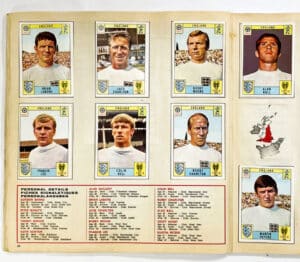
Panini’s most defining next step was the license it secured with FIFA, the world’s governing soccer body, to create stamps and an official album for the 1970 World Cup held in Mexico. For Panini collectors, 1970 means everything, and a complete album from that year is considered the “Holy Grail” among Panini collectors.
The first page of 50 in the 1970 album is dedicated to the Mexico ‘70 World Cup, with the next eight pages containing a brief history of each of the eight FIFA World Cups until that date, with three of the main players from each winning team receiving a card each. The bulk of the album is based on the theme—now a standard in Panini World Cup albums—with each team’s logo, team photo, and a place for player stamps. The cards were given multilingual captions and for the first time were offered for sale outside Italy.
The combination of self-adhesive peel-off stickers and cardboard cards is what makes Panini Mexico 70 unique. All the players and teams have been printed on thick cardboard cards which can be put into the album by using glue or scotch tape, while posters and flags are produced as self-adhesive stickers.
At the time, the 1970 album cost around two Mexican pesos, and a pack of five stickers cost around 20 or 25 cents. Since then, the value of complete albums and stickers of certain players have given rise to a commercial market for Panini stickers and albums, especially stickers and albums from this 1970 commemorative album.
In 2014, it was reported that a 1970 Mexico Panini album plus a complete set of stickers sold for over $8,400 on eBay, as reported in CardzReview, the self-professed “ultimate stickers and card resource.” In 2018, a complete Mexico 70 album sold for £1,550 on eBay, and just this past December, it was noted that an album is expected to exceed that record-breaking price and realize £1,800 or more at auction. Individual stickers of certain players from that year and future World Cups, however, can far exceed these values and the cost of buying albums and stickers continues to rise as collectors worldwide look to fill in their albums with the more elusive and famed players.
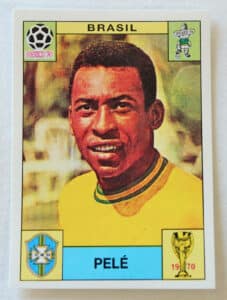
One of the most popular players of the 1970 World Cup is Pelé. A Pelé Panini card today from that game is valued at $11,000 (PSA 10). Other famed players from other World Cup tournaments realizing investment-grade values include Lionel Messi, whose card from the 2014 World Cup sold for an astounding £115,000, and Christiano Ronaldo from the 2002 games in Korea/Japan, which recently realized £60,000.
“The thing about the World Cup is it’s just an absolute global phenomenon,” said Panini America CEO Mark Warsop in a 2018 interview in Sports Illustrated. “The backbone of our business has been built on the back of the World Cup since we did our first collection in 1970. It’s the one sport that’s followed by every country on the planet.”
Today, it is said the World Cup unofficially kicks off when Panini releases its sticker album. The Company claims it prints 11 million sticker packets a day in the months leading up to this quadrennial competition. The 2022 U.S. edition featured 670 stickers across 80 pages, representing players from all 32 countries that competed in the event.
Panini America
Panini made its entry into the U.S. in 2009 by purchasing the assets of Donruss Corporation, a popular sports trading card company from Pennsylvania that had been around since 1954. In addition to establishing a position in the U.S. trading card market with the acquisition of Donruss, Panini was able to get the exclusive in the NBA to produce trading cards and signed Kobe Bryant as a global brand ambassador.
Kobe Bryant’s familiarity with the Panini brand goes back to when he was a kid growing up in Italy when he himself collected Panini stickers. Kobe Bryant’s vision from 2009 still influences the Panini brand and the company continues to honor his legacy to both the sport and the Panini brand.
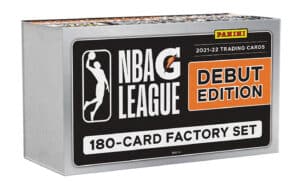

In 2016, Panini America signed a ten-year contract with the NFL for an incredible $300 million to become the dominant force in the card business, coupling its massive global platform with exclusive rights to those massive sports franchises and displacing Topps in a marketplace that had long been their domain.
Today, Panini America has official licenses to distribute trading cards for the NBA, NFL, WNBA, NASCAR, UFC, and other popular sports franchises, yet its exclusivity agreements with some of these franchises are being challenged by competitors.
In 2021, apparel manufacturer Fanatics purchased the rights to produce MLB, NBA, and NFL cards in a deliberate move to replace Panini as the big guy on the block. To move into this space, Fanatics purchased Topps, America’s oldest and most respected sports card company. When Panini’s exclusive licenses expire in 2025, collectors will be asked to choose between Panini Prizm cards and the beloved Topps Chrome industry standard for football and basketball cards. How this will shake out is only speculation at this point but the level of investment being made by these card companies in the U.S. market is proof that sports trading cards are as popular as ever here and around the world.
Old School Trading
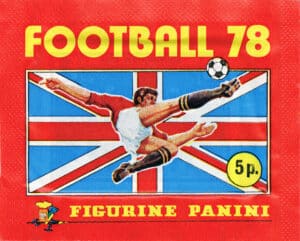

So what makes a little piece of paper with some adhesive on it so special and worth collecting and saving for over a half-century? Jon Wertheim of CBS’ 60 Minutes posed just that question to Francesco Furnari, the biggest official Panini distributor in the United States and Panini sticker evangelist, back in August 2023 in an interview for 60 Minutes.
“Jon, you gotta understand that you have all your legends. You have all your best players at a distance of, you know, your hand. You can touch them, you can talk to them. It’s fantastic.” Furnari is proud to share that he’s completed every sticker album since 1974, including the 2022 vintage, many times over.
Furnari points out that part of its appeal is that collecting Panini stickers is an inter-generational hobby that can be enjoyed by sports fans and collectors of all ages. Although Panini’s primary customers were initially children, today the company estimates that roughly 40 percent of their collectors are adults.
Panini cards are also a favorite among the players they immortalize. Gigi Buffon, who literally saved Italy during its run to the World Cup trophy in 2006, is himself an avid, life-long Panini collector. Buffon shared with Jon Wertheim in the 60 Minutes interview that the players themselves swap stickers in the locker room. “I think if we were really to investigate all the players in the locker room, I think 60 to 70 percent filled the album.”
When questioned why Panini stickers are so popular in a digital world, Furnari’s response is one all true collectors can understand. “This sensation – to get a pack, to rip it out, to smell it, to open it, and to find the players right here, there is no way you can replicate it in an electronic way.”





Related posts: